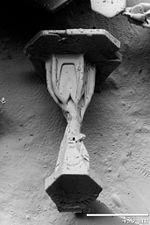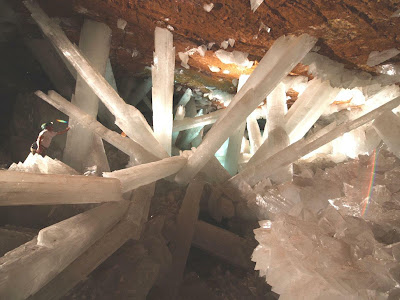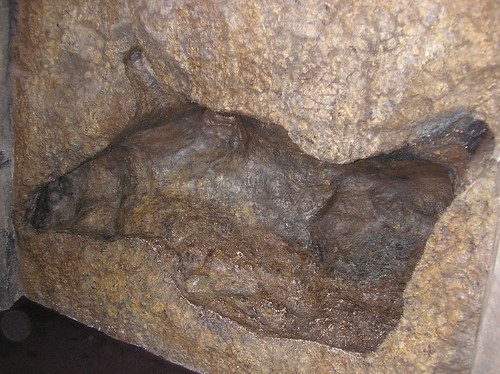Possible electrical scars on Planet Earth...
- webolife
- Posts: 2539
- Joined: Mon Mar 17, 2008 2:01 pm
- Location: Seattle
Re: Amazing Rock Formations
#6 is columnar andesite, or similar volcanic lava. I see quite a bit of this hiking on Mt. Rainier.
I've seen the quartzite in mudcracked sandstone in the field as well. Always very "manna" like at first impression...
"manna" = "what is this?"
I definitely go for rapid formation of many of those other rock formations... the crisscossed boulder [#1] is just incredible!
I don't think any of them are "single mechanism" products, but wouldn't it be something to find such a boulder in your backyard after a thunderstorm?
I've seen the quartzite in mudcracked sandstone in the field as well. Always very "manna" like at first impression...
"manna" = "what is this?"
I definitely go for rapid formation of many of those other rock formations... the crisscossed boulder [#1] is just incredible!
I don't think any of them are "single mechanism" products, but wouldn't it be something to find such a boulder in your backyard after a thunderstorm?
Truth extends beyond the border of self-limiting science. Free discourse among opposing viewpoints draws the open-minded away from the darkness of inevitable bias and nearer to the light of universal reality.
-
Lloyd
- Posts: 4433
- Joined: Fri Apr 04, 2008 2:54 pm
Re: Amazing Rock Formations
* That first image you mention, you notice, looks like triangles with parallel lines going across them. Snowflakes have hexagonal patterns, which triangles can form. Six equilateral triangles form a hexagon. Is any of that meaningful somehow?
* Oh, and by the way, the giant crystals in caves and the small ones in geodes are also hexagonal, quite a bit.
* Oh, and by the way, the giant crystals in caves and the small ones in geodes are also hexagonal, quite a bit.
- webolife
- Posts: 2539
- Joined: Mon Mar 17, 2008 2:01 pm
- Location: Seattle
Re: Amazing Rock Formations
Cleavage planes in a crystal and cleavage planes in a rock are two different animals, er... minerals.
Truth extends beyond the border of self-limiting science. Free discourse among opposing viewpoints draws the open-minded away from the darkness of inevitable bias and nearer to the light of universal reality.
-
seasmith
- Posts: 2815
- Joined: Thu Mar 27, 2008 6:59 pm
Re: Amazing Rock Formations
~
The working analogy for cleavage to crystal plane is that of the relation of Crystal to Grain.
Or Cellular structure to Grain, in organics.
Both could be said to follow an EM template or domain, onto-logically.
~s~
Webo,Cleavage planes in a crystal and cleavage planes in a rock are two different animals, e...
The working analogy for cleavage to crystal plane is that of the relation of Crystal to Grain.
Or Cellular structure to Grain, in organics.
Both could be said to follow an EM template or domain, onto-logically.
~s~
-
Lloyd
- Posts: 4433
- Joined: Fri Apr 04, 2008 2:54 pm
Re: Amazing Rock Formations
* How do you suppose electrical forces might shape rocks in so many ways?
* And what about rocks like these below?
1. 2.
2. 
3.
* That first rock is a snow crystal. Hexagonal craters were said in one TPOD to be formed by having a central electrical current filament surrounded by 6 peripheral filaments. I don't know why the outer filaments don't seem to leave any other trace outside of the hexagonal crater. Are crystals formed by similar electric current filaments? Are crystals pulled out of a surface, like mesas are thought by EU theorists to be pulled up out of flat terrain?
* Why are the #2 crystals angular, while in #3 they're covered with little bumps? Would water or humidity be involved in one or both events?
* And what about rocks like these below?
1.
 2.
2. 
3.

* That first rock is a snow crystal. Hexagonal craters were said in one TPOD to be formed by having a central electrical current filament surrounded by 6 peripheral filaments. I don't know why the outer filaments don't seem to leave any other trace outside of the hexagonal crater. Are crystals formed by similar electric current filaments? Are crystals pulled out of a surface, like mesas are thought by EU theorists to be pulled up out of flat terrain?
* Why are the #2 crystals angular, while in #3 they're covered with little bumps? Would water or humidity be involved in one or both events?
-
Lloyd
- Posts: 4433
- Joined: Fri Apr 04, 2008 2:54 pm
Re: Amazing Rock Formations
* In my initial posting of images on this thread, it looks like #2 and or #7 might be explained by mud drying out, as in the image below, and hardening, maybe by electrification, and then the cracks being filled in and then hardened as well. Does that sound likely?


- webolife
- Posts: 2539
- Joined: Mon Mar 17, 2008 2:01 pm
- Location: Seattle
Re: Amazing Rock Formations
The regularity of the pattern in your very first images is astounding for the typical mudcrack mechanism.
I've photographed a number of dry lake bottoms in an earlier study of "varve" formation I did as a much younger man...
Nothing I've seen in the mud crack arena has come close to the parallel line structure sandwiching the hexagonal "rays" of rock you show there. The "twinned" jointing is also barely imaginable. I'm wanting to know if that rock material is sedimentary, eg. limestone? Does it have a sedimentary matrix? Volcanic? Volcanic matrix? Granitic, ie. intrusive igneous origin? As for the cave crystal formations, I strongly favor an electrical field interaction... I picture myself as a lad holding a staticky comb next to a thin stream of water flowing from the bathroom faucet... the mega crystals are absolutely riveting challenges to the standard model of slow gradual evaporation over eons.
I've photographed a number of dry lake bottoms in an earlier study of "varve" formation I did as a much younger man...
Nothing I've seen in the mud crack arena has come close to the parallel line structure sandwiching the hexagonal "rays" of rock you show there. The "twinned" jointing is also barely imaginable. I'm wanting to know if that rock material is sedimentary, eg. limestone? Does it have a sedimentary matrix? Volcanic? Volcanic matrix? Granitic, ie. intrusive igneous origin? As for the cave crystal formations, I strongly favor an electrical field interaction... I picture myself as a lad holding a staticky comb next to a thin stream of water flowing from the bathroom faucet... the mega crystals are absolutely riveting challenges to the standard model of slow gradual evaporation over eons.
Truth extends beyond the border of self-limiting science. Free discourse among opposing viewpoints draws the open-minded away from the darkness of inevitable bias and nearer to the light of universal reality.
-
tesla
- Posts: 13
- Joined: Tue Apr 15, 2008 3:13 am
- Location: Sydney Australia
Re: Amazing Rock Formations
Here is another one near Sydney, Australia. A circular crater with a cone shaped structure in the middle with a crater in that. Looks great on Google Earth.
Garry Maxfield
Garry Maxfield
- MGmirkin
- Moderator
- Posts: 1667
- Joined: Thu Mar 13, 2008 11:00 pm
- Location: Beaverton, Oregon, USA
- Contact:
Re: Amazing Rock Formations
Heck, you want to see #6, just drive down the Columbia River Gorge... I recall having seen plenty of rock faces looking just like that while driving on a long road trip to a certain conference in Las Vegas that shall remain nameless. Needless to say, lots of interesting geology. Not least of all what appeared to be cloven mountains I was driving through on my way to Vegas via Idaho & the Nevada Desert. Wish I had then the camera I have now. My old 3MP unit (Canon A70) just didn't quite cut it to get the shots I would have liked to have taken (okay pics, but not "stellar"). My new 12MP unit (Canon G9) probably would have turned out some bloody brilliant shots.webolife wrote:#6 is columnar andesite, or similar volcanic lava. I see quite a bit of this hiking on Mt. Rainier.
Anywho...
~MG
"The purpose of science is to investigate the unexplained, not to explain the uninvestigated." ~Dr. Stephen Rorke
"For every PhD there is an equal and opposite PhD." ~Gibson's law
"For every PhD there is an equal and opposite PhD." ~Gibson's law
- webolife
- Posts: 2539
- Joined: Mon Mar 17, 2008 2:01 pm
- Location: Seattle
Re: Amazing Rock Formations
Just curious, Michael, have you ventured northward into central Washington to the environs of Vantage or George, WA?
A few of my most favorite spots:
Frenchman Coulee... some great columnar basalt, rock climbers love it
Quincy Diatomite beds... across I-90 and up the hill
Dry Falls, and especially the Blue Lake Rhino... short but exhilirating hike to the world famous Rhino mold in the basalt cliff... Wow!
A few of my most favorite spots:
Frenchman Coulee... some great columnar basalt, rock climbers love it
Quincy Diatomite beds... across I-90 and up the hill
Dry Falls, and especially the Blue Lake Rhino... short but exhilirating hike to the world famous Rhino mold in the basalt cliff... Wow!
Truth extends beyond the border of self-limiting science. Free discourse among opposing viewpoints draws the open-minded away from the darkness of inevitable bias and nearer to the light of universal reality.
-
Lloyd
- Posts: 4433
- Joined: Fri Apr 04, 2008 2:54 pm
Re: Amazing Rock Formations
Frenchman Coulee
1.
2.
Blue Lake Rhino
3.
4.
http://www.spokaneoutdoors.com/rhino.htm
1.

2.

Blue Lake Rhino
3.

4.

http://www.spokaneoutdoors.com/rhino.htm
One of the most unusual fossils ever found in the Columbia Plateau is a mold and a few bones of a small rhinoceros. In 1935, a group of hikers found it in a cavity in the vicinity of Blue Lake a few miles south of Dry Falls. This fossil is commonly known as the "Blue Lake Rhino". The mold is preserved in pillow basalt overlying a thin sand bed. Probably the rhino, which was dead at the time, was lying in a small pond and as molten lava flowed into the lake and became chilled somewhat so that the lava did not burn the rhino up. A mold was formed around the dead body. Professional paleontologists have made a coast from the mold and have reconstructed the rhino. Above see a model showing how the animal may have appeared prior to burial. The actual rhinoceros measured about eight feet from snout to tail.
-
M3RK
- Posts: 2
- Joined: Wed Sep 02, 2009 10:53 am
- Location: Florida
American Samoa
I did a quick search and couldn't find anything on this so here it is:
I was browsing around Google Maps last night looking for remote islands that would be fun to visit and I happened across America Samoa. The thing that struck me was first the 2 large chasms that dominated the largest island's landscape, and uppon further examination I saw something more interesting; a string of craters. Here's a link to the Google Maps site:
http://maps.google.com/maps?hl=en&ie=UT ... 4&t=h&z=12.
To my untrained eye it does not look as though these craters are extinct volcanoes as there is a lack of scarring from lava flows as shown on Hawaii:
http://maps.google.com/maps?hl=en&ie=UT ... 4&t=h&z=12.
Plus they are too well defined and actually look like craters on mars (with trees on them of course). Just some thoughts, what do you guys think? Have the EU guys looked any further into this?
I was browsing around Google Maps last night looking for remote islands that would be fun to visit and I happened across America Samoa. The thing that struck me was first the 2 large chasms that dominated the largest island's landscape, and uppon further examination I saw something more interesting; a string of craters. Here's a link to the Google Maps site:
http://maps.google.com/maps?hl=en&ie=UT ... 4&t=h&z=12.
To my untrained eye it does not look as though these craters are extinct volcanoes as there is a lack of scarring from lava flows as shown on Hawaii:
http://maps.google.com/maps?hl=en&ie=UT ... 4&t=h&z=12.
Plus they are too well defined and actually look like craters on mars (with trees on them of course). Just some thoughts, what do you guys think? Have the EU guys looked any further into this?
One who puts on his armor should not boast as one who takes it off.
- MGmirkin
- Moderator
- Posts: 1667
- Joined: Thu Mar 13, 2008 11:00 pm
- Location: Beaverton, Oregon, USA
- Contact:
Re: American Samoa
Hadn't seen those before... Interesting. And you're right some of the features do look considerably similar to Mars... I'm thinking the "lava tubes," so called of Arsia / Ascraeus mons.
Also rather interested in this feature:
http://maps.google.com/maps?t=h&ll=-13. ... 45912&z=18
Best,
~Micheal Gmirkin
Also rather interested in this feature:
http://maps.google.com/maps?t=h&ll=-13. ... 45912&z=18
Best,
~Micheal Gmirkin
"The purpose of science is to investigate the unexplained, not to explain the uninvestigated." ~Dr. Stephen Rorke
"For every PhD there is an equal and opposite PhD." ~Gibson's law
"For every PhD there is an equal and opposite PhD." ~Gibson's law
- nick c
- Site Admin
- Posts: 2483
- Joined: Sun Mar 16, 2008 8:12 pm
- Location: connecticut
Re: American Samoa
hi M3RK,
If vulcanism can be ruled out, then we must look at EDM.
They do bear a resemblance to [url2=http://en.wikipedia.org/wiki/Pedestal_crater]Pedestal Craters[/url2] common on Mars.
Forget about the impact stuff:
http://themis.asu.edu/feature_utopiacraters
If vulcanism can be ruled out, then we must look at EDM.
They do bear a resemblance to [url2=http://en.wikipedia.org/wiki/Pedestal_crater]Pedestal Craters[/url2] common on Mars.
Forget about the impact stuff:
http://themis.asu.edu/feature_utopiacraters
nick cPedestal craters, including their bottoms, stand above the elevation of the surrounding terrain.
[...]
From an Electric Universe point of view, these craters are enormous fulgamites, raised blisters like those found on the metal caps of lightning arrestors after a lightning strike. Because the whole blister is lifted above the surface by the lightning arc, the crater at the top is not necessarily deeper than the elevation of the original surface around it.
http://www.thunderbolts.info/tpod/2005/ ... raters.htm
-
kmerrell
- Posts: 14
- Joined: Tue Jun 24, 2008 6:12 am
Mini Tunguska event noted in Irkutsk region of Siberia
A brief note on a what appears to have been a meteroite exploding over the skies of Irkutsk region of Siberiain Siberia in 2002 seems to shed some bit of light on the famed Tunguska event of 1908. Electrical start to finish—
http://www.wired.com/thisdayintech/2009 ... -meteorite
http://www.wired.com/thisdayintech/2009 ... -meteorite
Who is online
Users browsing this forum: No registered users and 11 guests